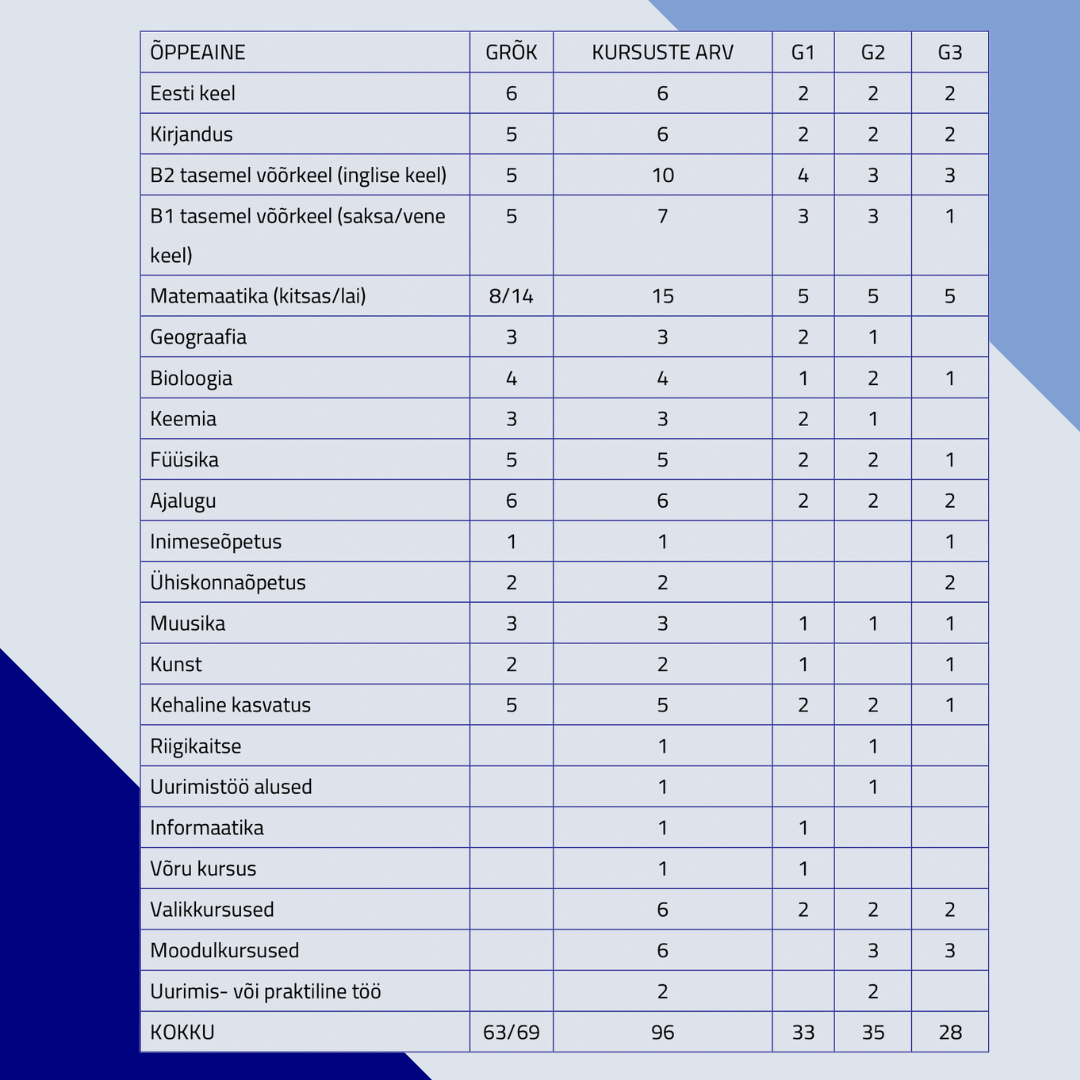Kooli õppekava
Valikkursuste ainekavad
Moodulite tutvustused
Õpilase hindamise tingimused ja kord
Küpsuseksami eristuskiri
Lühitutvustus:
Õppetöö toimub Gümnaasiumi riikliku õppekava (GRÕK) alusel. Vastavalt kooli õppekavale on õpilase minimaalne õppekoormus gümnaasiumi jooksul 96 kursust (1 kursus koosneb 21 tunnist (1 tund = 75min)). Neist 69 on õppeainete kohustuslikud kursused, mis on ühesugused ja kohustuslikud kõigile Eesti gümnaasiumiõpilastele. Kooli poolt ettenähtud kohustuslikud lisakursused on kirjandusele, B2-keeleoskustasemel võõrkeelele, B1-keeleoskustasemel võõrkeelele ja matemaatikale juurde antud kursused, uurimistöö alused, riigikaitse, informaatika, Võru kursus ning uurimis- ja praktilise töö kirjutamine.
Moodulkursuseid õpitakse G2 ja G3 aastal. Valikmoodul koosneb kolmest kursusest, mis läbitakse ühe õppeaasta jooksul (igal perioodil üks). Õpilane võib kahe aasta jooksul valida ühe valdkonna mooduleid ja ehitada endale teadlikult n-ö õppesuuna. Õpilane, kes tahab oma huvisid veel avastada, saab valida mooduli ka erinevast valdkonnast (nt G2 ühest ja G3 teisest valdkonnast). Iga õpilast toetab mooduli valiku tegemisel mentor ja vajadusel õppenõustaja. Enne mooduli valimist tutvustavad õpetajad õpilastele mooduleid. Moodulite tutvustamine ja valimine toimub G1 ja G2 aasta kevadel. Moodulites on õppekohtade arv piiratud. Kui õpilane ei pääse esimesena eelistatud moodulit õppima, tuleb õppima hakata teist (või ka kolmandat) valikut.
Igal õpilasel tuleb valida kuus Võru Gümnaasiumis pakutavat valikkursust: G1 aastal 2 valikkursust, G2 aastal 2 valikkursust ja G3 aastal kaks valikkursust. Valikkursused on üldjuhul ülekoolilised ja need toimuvad selleks ette nähtud valikainete nädalatel. Nädala jooksul õpib õpilane ühte valikainet, muid õppeaineid sel ajal ei õpita. Valikaineid õpetavad Võru Gümnaasiumi õpetajad ja koostööpartnerid. Valikainetele registreerumine toimub iga õppeaasta alguses.
Taotluse alusel võib kool õppetöö osana arvestada õpilase osalemist huvikoolis või mõnes muus väljaspool kooli aset leidvas õppetegevuses. Kool arvestab õpingute osana õpilase osalemist huvikoolis (nt õpingud muusikakoolis, kunstikoolis vm) või mõnes muus väljaspool kooli aset leidvas õppetegevuses, kui huvikooli esindaja esitab vastavasisulise taotluse õppeaasta alguses 1. oktoobriks, milles on andmed õpingute läbiviija (asutuse/organisatsiooni nimi, juhendaja ja tema kontaktandmed) ja andmed õpingute (kursuse/aine/õppetöö nimi, toimumise aeg, õpingute maht ja lühikirjeldus ning taotletavad õpitulemused) kohta. Kool hindab taotlust ja otsuse teeb direktor oma käskkirjaga. Kui otsus on positiivne, siis maikuu lõpuks tuleb huvikooli esindajal esitada hinneteleht/tõend/tunnistus õpilase õppetegevuses osalemise/õppetulemuste kohta.
Hea teada!
- Iga kursuse (sh valikkursuse) lõpus saab õpilane kursusehinde, ühe õppeaine kõigi kursusehinnete põhjal pannakse õppeaines koondhinne ehk kooliastmehinne, mis läheb lõputunnistusele;
- Hindamine toimub viiepallisüsteemis: 5 – “väga hea”, 4 – “hea”, 3 – “rahuldav”, 2 – “kasin”, 1 – “mitterahuldav”;
- Valikkursuste hindamisel kasutatakse üldiselt hinnanguid: “arvestatud” või “mittearvestatud”;
- Gümnaasiumi lõputunnistuse saab õpilane, kelle kooliastmehinded on vähemalt rahuldavad (valikkursuste puhul arvestatud) ning kes on sooritanud kolm riigieksamit (eesti keel, matemaatika, võõrkeel), sooritanud vähemalt rahuldavale tulemusele koolieksami ja koostanud õpilasuurimuse või praktilise töö;
- Gümnaasiumis arvestatakse kooli õppekavavälist õppimist ja tegevust, nt õppimine muusikakoolis, osalemine teaduskoolis, spordiga põhjalik tegelemine jms.
- Gümnaasiumis tuleb õppida vähemalt kahte võõrkeelt. Kolme aastaga tuleb mõlemas kohustuslikus võõrkeeles jõuda nii kirjalikult kui suuliselt kindlale keeleoskuse tasemele. Gümnaasiumilõpetaja keeleoskuse tasemeid nimetatakse B1 või B2 ja need on ühtsed kogu Euroopas.
